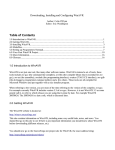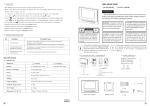Download portable C code
Transcript
Inform Software Corporation
6.1.4.
Chapter 6: Implementing Fuzzy Runtime Systems
Portable C Code
The source codes generated by the fuzzyTECH C code generator are portable.
Thus, fuzzy runtime systems can be implemented on any target platform for
which a C compiler exists. Any code generated by fuzzyTECH can be used
royalty-free. This applies also to the library, as long as it has not been modified
and is part of a project that was generated by fuzzyTECH.
Overview
An implementation of a fuzzy runtime system consists of at least three modules:
1. A fuzzy library, that stores the basic fuzzy algorithms which are independent
from any fuzzy system.
2. One or more fuzzy system modules generated by the C code generator of
fuzzyTECH. Each module contains code and data for its specific fuzzy logic
system.
3. One or more of your own software modules for implementing the application,
that uses the fuzzy logic system.
4. A communication module, that implements one of the communication
channels supported by fuzzyTECH. Note that this applies only to the
fuzzyTECH Online Edition. Even for this edition the usage of a
communication module is optional.
Figures 162 and 163 illustrate the hierarchy of these modules:
User Modules
Fuzzy
Fuzzy
...
Fuzzy Module
Module Module
N
1
2
fuzzyTECH C Runtime Library: Fuzzy Algorithms
Figure 162: Fuzzy Runtime Systems in C Language
User Modules
Fuzzy
Fuzzy
...
Fuzzy
Module 1 Module 2
Module N
fuzzyTECH C Runtime Library:
Fuzzy Algorithms
fuzzyTECH C
Runtime Library:
Online Module
Communication
Module
Figure 163: Fuzzy Runtime Systems And Online in C Language
278
fuzzyTECH® 5.3 User’s Manual
Inform Software Corporation
The steps to get an application to run and compute one or more fuzzy logic
systems are described in this section as follows: Section 6.1.4.1 explains the
steps to build your own fuzzy library. Section 6.1.4.2 describes the integration of
the user interface of the fuzzy system modules into your own source codes.
Users of the fuzzyTECH Online Edition may need to integrate a communication
module to support the online connection between the fuzzy runtime system and
the fuzzyTECH Shell. Refer to Section 6.1.4.3 for more details. Section 6.1.4.4
describes the process of linking all modules together to get an application
running.
6.1.4.1.
Building the fuzzyTECH C Runtime Library
Build Your Own Library
The library used by the C code generator is delivered as source code to keep the
C Code based fuzzy runtime systems portable to any platform. Therefore you
have to create the binary form of the library yourself. Building your own
fuzzyTECH C Runtime Library allows you to use your favorite compiler with
your favorite compiler settings for your favorite target CPU.
Note: You can use any C compiler for any target CPU. Neither does the
fuzzyTECH C Runtime Library need other libraries nor does it include files of
your compiler.
Note: The fuzzyTECH C Runtime Library has to be built for your personal
environment only once. Afterwards, it can be used for all fuzzy runtime systems
on this environment.
Directory
You should locate your library in the directory …\RUNTIME/C/LIB. All
necessary source codes for building the library can be found in the directory
…\RUNTIME/C/LIB/SRC.
To do
Due to the great number of different C compilers, this section is a rather general
description and not a step-by-step guidance. It may be necessary to browse your
compiler manual to realize the building steps. The library consists of many
modules. You will find one C source file for each module.
1. Important: Set the fuzzy library preprocessor definitions. Please refer to
Section 6.1.4.1.1 for details.
2. Compile all *.C source files to *.OBJ binary object files.
3. Move all *.OBJ files to the library.
Please refer to the manual of your compiler, if you are not firm with these steps.
Note: You can use both the command line version and, if available, the
integrated development environment (IDE) of your compiler. For some compiler
tool kits the library manager may be a separate tool.
Compiler Settings
Due to the great number of very different C compilers, this section can give only
some general hints. Some compilers offer options for optimizing the library
279
Inform Software Corporation
Chapter 6: Implementing Fuzzy Runtime Systems
either for size or for speed. Note: Some compilers may support different memory
models (small, medium, large, ...). Make sure that the fuzzy library was compiled
for the same memory model as your application to be linked with the fuzzy
library. If you want to use different memory models you have to build separate
libraries for each memory model. Please refer to your compiler manual for more
details.
Sample
The batch file FTMAKE.BAT creates the fuzzy library for the PC based C
compilers of Microsoft or Borland. It is based on the command line versions of
both compilers. You may use this file as sample for adapting your compiler.
6.1.4.1.1.
Preprocessor Definitions
What Is It?
Preprocessor definitions are standard control elements in the C language to build
if-else-constructs that are evaluated at compile time. The same source code can
thus be used for multiple purposes. C programmers generally use preprocessor
definitions together with the statements: #define and #ifdef.
Why Is Their Usage
Essential?
Different fuzzyTECH Editions need different fuzzyTECH C Runtime Libraries.
The building process for the different libraries is controlled by preprocessor
definitions. You have to set one or more preprocessor definitions to build a
library that matches the C code generated by your fuzzyTECH Edition. Some
Editions may generate C code for different computation resolutions. The
computation resolution is determined by the base variable type selected in the
Project Options dialog Global. These editions need two libraries, one for 8-bit
resolution and one for 16-bit or ‘double’ resolution.
Where Can They Be Set?
Preprocessor definitions on compile time can either be set in the command line
of your compiler or in a dialog of your integrated development environment.
Please refer to the manual of your compiler.
Note: Most C compilers support in the command line version the switch -D or
/D to set a preprocessor definition.
Which Shall Be Set?
Refer to the tables below to find out which preprocessor definition must be set
for which library and which edition.
Edition
Professional
Online
MCU-C, MCU-MP
MCU-166, MCU-320, MCU-96
MCU-51, MCU-ST6, MCU-374,
MCU-11/12
Library Name
FTC16.LIB
FTC8.LIB
FTC16.LIB
FTC8.LIB
FTC16.LIB
FTC8.LIB
FTC16.LIB
FTC8.LIB
280
Preprocessor Definitions
FTLIBC16 PRECOMPILER
FTLIBC8 PRECOMPILER
FTLIBC16 ONLINE
FTLIBC8 ONLINE
FTLIBC16
FTLIBC8
FTLIBC16
FTLIBC8
(optional)
FT_KRC
FT_KRC
FT_KRC
FT_KRC
fuzzyTECH® 5.3 User’s Manual
Inform Software Corporation
Preprocessor Definition
Description
FTLIBC16
Enables 16 bit computation resolution.
Note: The double interface of the code generator uses 16 bit resolution too.
Enables 8 bit computation resolution.
Enables additional data used by the non MCU fuzzy algorithms.
Enables the support of Kernighan&Ritchie C compilers. The default is
ANSI-C.
FTLIBC8
PRECOMPILER
FT_KRC
Sample
Assuming you use the fuzzyTECH Professional Edition and the Microsoft Visual
C/C++ Compiler. In order to create a library with 16 bit computation resolution
you may compile all C files in the directory RUNTIME/C/LIB/SRC with the
following command line call:
cl.exe -c -DFTLIBC16 -DPRECOMPILER *.C
where cl.exe is the call to the Microsoft compiler, -c is the compiler
command for generating object files only, -D is the command to set the
preprocessor definitions and *.C is the wildcard for all C source files in the
current directory.
6.1.4.2.
Using the Generated Module
Generate the C Module
This section shows how C code generated by fuzzyTECH can be integrated in
your own software modules. Select “Tools\Compile to...\C...” in the main menu
of fuzzyTECH to generate the current fuzzy logic project as C code. The code
generator creates two files with the same name as the fuzzy system, one with the
file extension *.C, the other one with the extension *.H. The *.C file contains
code and data of the fuzzy logic system, the *.H file contains the export
interface of this module. Note, that the name of each exported function or
variable in this *.H file ends with the name of the fuzzy logic system. Note that
the generated modules use the project independent fuzzy logic algorithms of the
fuzzy library. Assuming you want to integrate two different fuzzy logic systems
in your application. Furthermore the fuzzy logic systems have the names
MYPROJ1.FTL and MYPROJ2.FTL. Generating the C-Modules for both
systems will create the files:
MYPROJ1.C, MYPROJ1.H
MYPROJ2.C, MYPROJ2.H
Overview
The following enumeration gives an overview about the steps necessary to
integrate a fuzzy system module into the source code of your software
module(s):
281
Inform Software Corporation
Chapter 6: Implementing Fuzzy Runtime Systems
1. Include C header files
• Include the export interface(s) of the fuzzy system module(s).
• fuzzyTECH Online Edition only: Include the export interface of the fuzzy
online module.
2. Initialization during startup of your application
• fuzzyTECH Online Edition only: Initialize the fuzzy online module.
• Initialize the fuzzy system module(s).
3. Computation of each fuzzy system module:
• Set the input variables.
• Call the fuzzy computation.
• Get the output variables.
4. fuzzyTECH Online Edition only: Call the fuzzy online communication.
5. fuzzyTECH Online Edition only: Trace control allows you to start or stop the
trace process with your own logical expressions.
Include Header Files
You have to include a *.H file for each fuzzy system module in your C source
code. Users of the fuzzyTECH Online Edition have additionally to include the
file ONLINE.H which is located at RUNTIME\C\INCLUDE. Add the
following lines to the include section of your source code.
/*all fuzzyTECH Editions
*/
/*include the export interfaces of the fuzzy systems*/
#include "myproj1.h"
/*fuzzy system 1*/
#include "myproj2.h"
/*fuzzy system 2*/
/*fuzzyTECH Online Edition only
*/
/*include the export interface of the online module */
#ifdef FT_ONLINE
#include "online.h"
/*fuzzy online manager*/
#endif
Initialization
Each fuzzy system module must be initialized only once during the startup of the
application. The initialization function has no parameters and no return value.
Users of the fuzzyTECH Online Edition have to initialize the fuzzy online
module additionally. It’s important to do this before initializing the fuzzy system
modules. Add the following lines to the part of your source that contains the
startup sequence.
/*fuzzyTECH Online Edition only
*/
/*initialize the fuzzy online manager
*/
#ifdef FT_ONLINE
initonline();
/* must be done first */
#endif
/*all fuzzyTECH Editions
/*initialize the fuzzy system modules
initmyproj1();
initmyproj2();
282
*/
*/
fuzzyTECH® 5.3 User’s Manual
Inform Software Corporation
Fuzzy Computation:
Parameter Passing
The fuzzyTECH C code generator supports two different possibilities of passing
the input and output variable values between your source code and the fuzzy
system module. This option is controlled by the Public Input and Output
checkbox in the dialog “Project Options/Code Generator”.
Depending on your setting you get C code with a computation function using:
1. Function Parameters
2. Global Variables.
Note that global variables will probably be easier to handle, if you change the
number of input or output variables of your fuzzy logic system. The resulting
code may also be a little bit faster.
Fuzzy Computation:
Data Type and Range
of the Variables
Fuzzy Computation:
Function Prototype
The fuzzyTECH C code generator supports different data types for input and
output variables of the fuzzy system. The data type is defined by the radio
buttons Base Variable Data Type in the dialog “Project Options/Global”.
Depending on the setting in this dialog you get C code using variables with
1. Data type FUZZY, which is 8 bit unsigned integer.
Value range: The code values set in the Variables Properties: Base dialog.
2. Data type FUZZY, which is 16 bit unsigned integer.
Value range: The code values set in the Variables Properties: Base dialog.
3. Data type double, which is the C standard type.
Value range: The shell values set in the Variables Properties: Base dialog.
The function name for the fuzzy computation is in any case the same as given for
the fuzzy logic system itself. Depending on the chosen parameter passing and
data type options the fuzzy computation function exported in the *.H file will
have different prototypes.
1. Global variables, all data types:
FLAGS myproj1(void);
2. Function parameters, data type FUZZY:
FLAGS myproj1(FUZZY in1, FUZZY in2, ...,
FUZZY* out1, FUZZY* out2, ...);
3. Function parameters, data type double:
FLAGS myproj1(double in1, double in2, ...,
double* out1, double* out2, ...);
If you use global variables the *.H file exports all input and output variables of
the fuzzy logic system with the correct data type automatically. The names of
these variables are constant. They are based on the names you have used in
fuzzyTECH and follow this scheme:
<Variable Name>_<Module Name>
<Term Name>_<Variable Name>_<Module Name>
283
Inform Software Corporation
Chapter 6: Implementing Fuzzy Runtime Systems
If you use the function parameter interface, you have to declare variables in your
source code. One variable for each input and each output of the fuzzy logic is
recommended. You are free to use any names for these variables, but their data
type has to be either double or FUZZY. When calling the computation
function, you have to place your variables at the correct position that matches the
fuzzy logic system. In any case the function needs first the inputs. They are in
alphanumeric order sorted by the variable names used in fuzzyTECH. The
function expects call-by-reference parameters after the inputs. This is one pointer
for each output variable in alphanumeric order.
Fuzzy Computation:
Function Call
Assuming that the code of MYPROJ1 uses function parameters, the code of
MYPROJ2 uses global variables, and both fuzzy systems use the data type
FUZZY, your source code may look like the following pseudo C code:
/*i/o-handling and computation
*/
/*fuzzy system MYPROJ1 with function parameters
*/
FLAGS flags;
/*declare some variables of data type FUZZY
FUZZY a, b, c, ...; /* your variables */
FUZZY x, y, z, ...; /* your variables */
...
/*compute the fuzzy system */
flags = myproj1(a, b, c, ...,&x, &y, &z, ...);
...
...
...
/*i/o-handling and computation
*/
/*fuzzy system MYPROJ2 with global variables
*/
/*set all input variables of the fuzzy system */
in1_myproj2 = ...; /* variables exported by MYPROJ.H */
in2_myproj2 = ...; /* variables exported by MYPROJ.H */
in3_myproj2 = ...; /* variables exported by MYPROJ.H */
...
/*compute the fuzzy system */
flags = myproj2();
/*use the output variables of the fuzzy system */
... = out1_myproj2; /* variables exported by MYPROJ.H */
... = out2_myproj2; /* variables exported by MYPROJ.H */
... = out3_myproj2; /* variables exported by MYPROJ.H */
...
Fuzzy Computation:
Return Value
The fuzzy computation function returns a value of the type FLAGS with the
fuzzy logic inference control flags. Each bit in FLAGS represents one output
variable, starting with the lowest order bit and assigned in sequence to the output
variables in alphanumeric order. A zero bit for a variable indicates that for this
output variable at least one rule has fired. Hence, a return value of zero indicates
that for every output variable at least one rule has fired. The number of bits of
the data type FLAGS depends on the fuzzyTECH Edition:
284
fuzzyTECH® 5.3 User’s Manual
Inform Software Corporation
fuzzyTECH Edition
Professional, Online
MCU-96, MCU-166, MCU-320
MCU-C, MCU-ST6, MCU-MP,
MCU-51, MCU-11/12
FLAGS
32 bit integer
16 bit integer
8 bit integer
Consider a fuzzy logic system with four (4) output variables: A_Output,
B_Output, C_Output and D_Output. For this system, the bits 3...0 of the return
variable correspond to variable A_Output ... D_Output. All higher order bits are
not used. A return value of 5, evaluated in a specific control cycle, indicates that
no rule has fired for the second and the forth output variable.
32-bit
value
FLAGS
flags=5
Variables in
Output Interface
Output
Value
MSB: 31
30
29
28
27
0
0
0
0
0
...
0
...
0
0
1
0
1
not used
not used
not used
not used
not used
...
not used
...
not used
A_Output
B_Output
C_Output
D_Output
...
...
calculated
default-value
calculated
default-value
...
4
3
2
1
LSB: 0
Figure 164: Return Flags of a Return Value 5 for a System With Four Output
Variables (32-bit FLAGS type)
Online Communication
The fuzzyTECH Online Edition has the option to enable an online connection
with your fuzzy runtime system. Add a call to the fuzzy online module in your
source code to support this communication mechanism.
/*fuzzyTECH Online Edition only
#ifdef FT_ONLINE
online();
/* call the online module
#endif
*/
*/
Note that you must call this function regularly and as often as possible.
Otherwise the online communication will run into a time-out. For example, if
your application has a kind of main control loop, this would be the best place to
insert the function call.
285
Inform Software Corporation
Chapter 6: Implementing Fuzzy Runtime Systems
Note that the function online() should not interrupt the computation of the
fuzzy systems. This is important, in case you use a timer interrupt to call this
function.
Note that the function online() is programmed in such a way that it consumes
as little time as possible. During an active online connection it copies the
maximum number of 76 bytes and sends an answer to fuzzyTECH before it
returns. If no active online connection is running, the function returns
immediately.
Trace Control
The fuzzyTECH Online Edition offers the option to generate C code supporting a
trace buffer that records the input and output values of the fuzzy system in realtime in your application. During an online connection the trace process is
controlled by the Trace Control dialog. The dialog offers an option to start or
stop the trace process by external trigger events. Therefore the generated C code
exports two additional functions that control the trace process. Call these
functions in your source code to start or stop the trace at arbitrary logical
conditions. Note that once the Trace process has been started, multiple calls of
the following start and stopp function are ignored:
/*fuzzyTECH Online Edition only
*/
/*evaluate your own logical conditions
*/
/*to start or stop the trace process
*/
#ifdef FT_ONLINE
if((fCond1 && fCond2) || fCond3) /*this is a sample!*/
StartTracemyproj1();
else
StopTracemyproj1();
#endif
Code Samples
The following pseudo C code samples illustrates the user interface of the fuzzy
modules for different settings of the code generator options, i.e. base variable
data type and parameter passing.
286
fuzzyTECH® 5.3 User’s Manual
Inform Software Corporation
/* Example 1: MYMAIN.C */
/* single fuzzy project, function parameters, integer data type */
#include "myproj.h"
...
...
void main(void) {
FUZZY myin1, myin2,..;
FUZZY myout1, myout2,..;
FLAGS rv;
...
initmyproj();
...
while(!stop) {
...
myin1 = ...
myin2 = ...
...
rv = myproj(myin1, myin2,..,
&myout1, &myout2,..);
... = myout1;
... = myout2;
...
}
...
}
287
/*
/*
/*
/*
/*
/*
/*
/*
/*
/*
/*
/*
/*
/*
/*
/*
/*
/*
/*
/*
/*
/*
/*
include fuzzy system
more includes
more declarations
main program
declare local variables
declare local variables
declare return value
more code
initialize fuzzy system
more code
control loop
more code
set the input variable
set the input variable
more code
call the fuzzy system
*/
*/
*/
*/
*/
*/
*/
*/
*/
*/
*/
*/
*/
*/
*/
*/
*/
use the output variables */
use the output variables */
more code
*/
end of control loop
*/
more code
*/
end of main program
*/
Inform Software Corporation
Chapter 6: Implementing Fuzzy Runtime Systems
/* Example 2: MYMAIN.C */
/* single fuzzy project, function parameters, double data type */
#include "myproj.h"
...
...
void main(void) {
double myin1, myin2,..;
double myout1, myout2,..;
FLAGS rv;
...
initmyproj();
...
while(!stop) {
...
myin1 = ...
myin2 = ...
...
rv = myproj(myin1, myin2,..,
&myout1, &myout2,..);
... = myout1;
... = myout2;
...
}
...
}
288
/*
/*
/*
/*
/*
/*
/*
/*
/*
/*
/*
/*
/*
/*
/*
/*
/*
/*
/*
/*
/*
/*
/*
include fuzzy system
more includes
more declarations
main program
declare local variables
declare local variables
declare return value
more code
initialize fuzzy system
more code
control loop
more code
set the input variable
set the input variable
more code
call the fuzzy system
*/
*/
*/
*/
*/
*/
*/
*/
*/
*/
*/
*/
*/
*/
*/
*/
*/
use the output variables */
use the output variables */
more code
*/
end of control loop
*/
more code
*/
end of main program
*/
fuzzyTECH® 5.3 User’s Manual
Inform Software Corporation
/* Example 3: MYMAIN.C */
/* multiple fuzzy systems, global variables, */
/* any data type, online support
*/
#include "myproj1.h"
/* include fuzzy system 1
*/
#include "myproj2.h"
/* include fuzzy system 2
*/
...
/* more fuzzy systems
*/
#ifdef FT_ONLINE
/*
*/
#include "online.h"
/* include online module
*/
#endif
/*
*/
...
/* more includes etc.
*/
void main(void) {
/* main program
*/
FLAGS rv;
/* declare return value
*/
...
/* more code
*/
#ifdef FT_ONLINE
/*
*/
initonline();
/* initialize online module */
#endif
/*
*/
initmyproj1();
/* initialize fuzzy system 1*/
initmyproj2();
/* initialize fuzzy system 2*/
...
/* initialize other systems */
...
/* more code
*/
while(TRUE) {
/* control loop
*/
...
/* more code
*/
myin1_myproj1 = ...;
/* set input data ...
*/
myin2_myproj1 = ...;
/*...for fuzzy system 1
*/
...
/*...more inputs
*/
rv=myproj1();
/* call fuzzy system 1
*/
... = myout1_myproj1;
/* transfer output data ... */
... = myout2_myproj1;
/*...to process
*/
...
/*...more outputs
*/
...
/* more code
*/
myin1_myproj2 = ...;
/* set input data ...
*/
myin2_myproj2 = ...;
/*...for fuzzy system 2
*/
...
/*...more inputs
*/
rv=myproj2();
/* call fuzzy system 2
*/
... = myout1_myproj2;
/* transfer output data ... */
... = myout2_myproj2;
/*...to process
*/
...
/*...more outputs
*/
#ifdef FT_ONLINE
/*
*/
online();
/* call online module
*/
#endif
/*
*/
...
/* more code
*/
}
/* end of control loop
*/
}
/* end of main program
*/
289
Inform Software Corporation
6.1.4.3.
Online Communication
Channels
Chapter 6: Implementing Fuzzy Runtime Systems
Online Communication Module
The fuzzyTECH Online Edition offers the option to enable an online connection
with your fuzzy runtime system. The fuzzyTECH Shell is running on a MS
Windows operation system while your fuzzy runtime system may run on a
different hardware platform. If you want to connect both systems, you have to
decide, which communication channel is the best for your purpose. In every case
both applications must use the same communication channel with the same
settings.
Communication Channels
of fuzzyTECH
fuzzyTECH supports different standard communication channels as the serial
interface, shared file systems and IPX/SPX. Note, that fuzzyTECH offers an open
interface. You may write your own DLL that uses other communication
channels. Refer to Section 7.2 for details.
Communication Channels
of Fuzzy Runtime System The main modules of the fuzzy online manager are part of the fuzzy library. This
does not include the layer that accesses to the hardware of the communication
channel. It is separated due to portability reasons. The module consists of two
files named COMM.C and COMM.H and has a fix interface that is used by the
fuzzy library. You will find source codes for some communication modules in
the sub-directories of …\RUNTIME\C\LIB\SRC\ONLINE\COMM. The file
README.TXT in this directory contains additional information. You will find
ready-to-go modules for:
1. MS DOS: Serial Interface
2. OS/2:
Serial Interface
3. All:
Shared File System
If you have decided which channel is the best for your target system, it may be
necessary to change the original source code to set your preferred parameters.
For example you may change the settings for the serial interface or you may
change the communication directory for shared file systems.
User Defined Modules
If you use an other platform for your fuzzy runtime system, you have to
implement your own communication module. A prototype can be found in
…\RUNTIME\C\LIB\SRC\ONLINE\COMM\USER\COMM.C. It contains four
empty functions that
1. initialize and open the communication channel,
2. close the communication channel,
3. transmit bytes to the communication channel,
4. receive bytes from the communication channel.
Please follow the instructions in the comments of the functions. Note, that you
should not change the function prototypes. If you need help or more information,
do not hesitate to contact our technical support.
290
fuzzyTECH® 5.3 User’s Manual
Inform Software Corporation
6.1.4.4.
Compiling and Linking
This chapter describes the compiling and linking process of all modules that are
part of the fuzzy runtime system. Due to the great number of different C
compilers, this section is a rather general description and not a step-by-step
guidance. It may be necessary to browse your compiler manual to realize the
building steps.
If you implement a new application please follow the steps of the enumeration
below. If you add a fuzzy runtime system into an existing application please
proceed analogously.
1. Check, whether your C compiler is installed correctly.
2. Check, whether you have built the fuzzy library.
3. Create a new project or makefile for your application.
• Add your software module(s) to the project.
• Add the fuzzy module(s) to the project.
If your edition supports different data types, please note that it’s not
possible to integrate 16 bit or double fuzzy modules together with 8 bit
fuzzy modules in the same application.
• Add the correct fuzzy library to your project.
FTC16.LIB
for fuzzy modules with data type 16 bit or double.
FTC8.LIB
for fuzzy module with data type 8 bit.
• Add the communication module to your project (Online Edition only).
• Add the directory …\RUNTIME\C\INCLUDE to the include file search
path of your compiler.
• Add the directory …\RUNTIME\C\LIB to the library search path of your
compiler.
4. Build the application.
• Compile your own module(s).
• Compile the fuzzy module(s).
• Compile the communication module (Online Edition only).
• Link all object files and libraries.
5. Execute the application.
Figure 165 illustrates the build process for the fuzzyTECH Online Edition. Note
that all other editions do not need the communication module.
291
Inform Software Corporation
Chapter 6: Implementing Fuzzy Runtime Systems
Figure 165: Building an Application with Fuzzy Runtime Systems and Online
6.1.4.5.
Examples
All fuzzyTECH Editions generating C code (refer to Table 5 of Section ) come
with at least one sample that shows the integration of the generated code in user
modules. The samples are located in the sub-directories of
…\RUNTIME\C\SAMPLES. More details about the samples can be found in
README.TXT.
MYMAIN Sample
This sample aims only to illustrate the user interface between your own code and
the generated fuzzy module. Note, that most parts of the source code are
dummies. There is no kind of display or interaction if you run the sample.
Directory and Files
This sample is located at …\RUNTIME\C\SAMPLES\MYPROJ.
It consists of following files:
MYPROJ.FTL fuzzy system
MYMAIN.C
your application code
MYPROJ.C
fuzzy module
MYPROJ.H
fuzzy module export interface
FTC16.LIB
your fuzzy library
292
fuzzyTECH® 5.3 User’s Manual
Inform Software Corporation
Build Procedure
For compilers of Microsoft or Borland the batch file BUILD.BAT demonstrates
all steps necessary to build an running application.
293

























